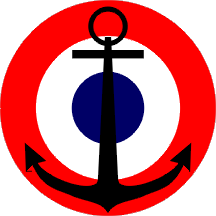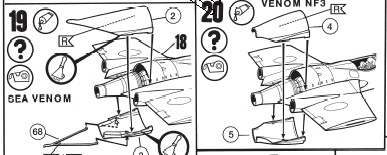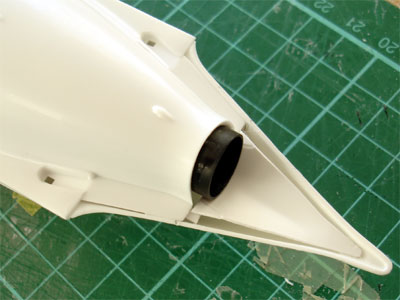(Sea Venom conversion)
[ page 1 ]
SNCASE Aquilon conversion in 1/32 scale made by Meindert de Vreeze
modelling report about...
SEA VENOM

A conversion was done to a SNCASE Aquilon, converting the 1/32 Matchbox Lesney PK-506 kit issued 1980.
The 1/32 Matchbox Lesney kits were known as being very good, with good accuracy and shape. I was told that the dimensions of the kit (length and span) were pretty well ( within a margin of a couple of millimetres) and I am not surprised as Matchbox did make simple but accurate kits at the time. They had access to the real thing. The kit had plastic in several colours.

Decals in this kit were for Royal Navy Fleet Air Arm 894 NAS Sea Venom Mk.22, Royal Australian Navy 805 squadron Mk.53 aircraft and Royal Air Force NF.mk 3 of 151 squadron.




This kit will be used for the 1/32 Aquilon conversion.
page 1
page 2
page 3
page 4
![]()

Aquilon
(premier jet
embarqué sur un porte-avions français)
After the Second
World War, the French Navy also worked on their naval power, modelling aircraft
carriers like the Foch and Clemenceau. So a shipboard jet fighter was needed
and in January 1951 the Aeronavale selected the Sea Venom FAW.20 as this
British ship board jet fighter in development seemed promising. With De
Havilland, arrangements were made for license manufacture by SNCASE (later
Sud-Aviation). The French Sea Venom was given the name of "Aquilon , French
for “Sea Eagle".

The versions
were:
* Aquilon 20
(de Havilland kits / licensed)
* Aquilon 201
(single prototype, based on FAW.20)
* Aquilon 202
(based on FAW.22)
* Aquilon 203
(a single seat all weather fighter with American APQ 94 radar and a
single pilot).
* Aquilon 204
(trainer model of the 202)
Introducing the Aquilon started with four "kitted" Sea Venom FAW 20 planes shipped from De Havilland. It was first flown in 1952 and about twenty "Aquilon 20" machines were built.
Improvements on the Aquilon were desired however, and a single prototype "Aquilon 201" made by Sud-Est. It was based on the Sea Venom NF Mk.52 but with a Fiat Ghost 48 mk.1 engine and a new rear-sliding canopy. It also got ejection seats built by Sud-Est; (some sources claim they were a Martin-Baker design built under license).
The first “new
all Sud built” production machine was the "Aquilon 202", flying March 1954
with a total of 25 jets built. It had an American radar and a Derveaux
DRAX-4A radar rangefinder. It featured ejection seats for both crew
members and an adapted rear-sliding canopy with changed canopy frames.
Also it got anti-skid brakes and was powered by a Fiat-built Ghost 48 mk.1
engine. The armament consisted of the usual four Hispano 20 mm cannons
in the lower fuselage nose.

The "Aquilon 203" came next, with 40 jets made. Based on Model 202, it was further modified. It got an American AN/APQ-94 radar and the radar equipment was so large that it demanded removal of the right seat, with now only the left seat for the flying pilot. The Aquilon 203 could also launch the Nord 5103 / AA.20 radio-guided AAM, with one carried under each wing. Later it was capable of firing R.511 semi-active radar homing AAM missiles and AS-20 air-to-surface missiles.
Some Aquilons were later modified as "Aquilon 204" radar trainers and stripped of armament and fitted with the AN/APQ-65 radar. Removal of the armament permitted again the fit of the second seat for the trainee. They had probably also short stroke legs, so were only usable on land based fields.
French Aquilons operated aircraft from their aircraft carriers and land bases. The French Aquilons were generally out of service by 1960, but some remained in training roles for a few more years.
Notes:
- All the production
Aquilons retained the larger/original De Havilland FAW.20 overhanging horizontal
tail plane with single trim tab. (The British Sea Venom FAW.20 had this
extended tail plane, but the following mk. 21 and later marks had these
deleted in the U.K. versions).
- The vertical
tails of the earlier Aquilons as on early Sea Venoms were a bit pointier
and had a pitot on the leading edge on the first planes.
- Fuselage
access panels in the nose differ between early and later Aquilon variants.
TECHNICAL
DATA AQUILON
=====================
S.N.C.A.S.E.
'Aquilon' type 202
Two-seater
version with ejector seats, an American radar AN/APQ-65 and air conditioning.
Span:
13.07 m
Length :
11.16 m
Height :
2.60 m
Crew: 2
De Havilland
'Ghost' 48 engine 2270 kgp
Max speed :
945 km/h
Armament :
4 Hispano 20 mm cannons
=====================
DATA
S.N.C.A.S.E.
'Aquilon' type 203
Single-seat
version with an American radar AN/APQ-94 and equipped with racks for the
air-to-air missiles.
Span:
13.07 m
Length :
11.10 m
Height :
2.31 m
Crew: 1
De Havilland
'Ghost' 48 engine 2270 kgp
Max speed :
945 km/h
Armament :
4 Hispano 20 mm cannons
So some sources
suggest that the Aquilon 503 was 0.06 m less long than the type 202, but
it could not be determined if and how this was done.
======================
"Aquilon 203" was made.
The model conversion report will indicate the step numbers as shown in the instructions; the order will be changed however to ease assembly. Making this model needs conversion and in addition, adding more detail would be nice. So the model would get folded wings (option of the kit), an opened engine bay (option of the kit) and a scratch build opened up nose avionics bay and radar nose.
![]()
Steps 1 - 2
The intake ducts were simply assembled,
but not a lot will be seen later on.
Steps 3 - 8
The Aquilon
model would have its engine access panel opened, this needed adding detail
in the engine area. With sprue and rod this was done. The basic Ghost engine
is provided in the kit.
 .
.
Steps 9-10
Next, the kit's interior was tackled; the kit is basic but offers an excellent base for detailing which is well visible
under the large open canopy. I searched on the Internet through
Google for pictures of the Aquilon cockpit. Not a lot was found.
Instrument panels were made from thin card with the dials and clocks drilled open. (later on I would put there decals for the clocks). The moulded trim wheel on the left side console was cut off and replaced. Some details like the control stick still to be fitted.
For the Aquilon
203,
the right seat was not to be installed as room was needed for
avionics boxes and equipment. I did not have detailed Aquilon cockpit photos but
“guesstimated” and added plastic from card and the spares box. I assumed a
radar
scope on the right but a similar cockpit instrument lay-out on the
left. The basic interior colours on these early jets were
“typically black” so
not a lot will be seen in detail anyway.
 ..
..
... old Matchbox
kit with differently coloured plastic parts....
In addition, this Aquilon 203 has a different rear sliding canopy with a larger front transparent section. I would have to make a new canopy, more on that later on.
![]()
Step 12
The basic fuselage was now assembled
as indicated in the instructions.
Steps 13-14
The 4 Hispano canon nozzles were
drilled open in part #8 and plastic open tubings glued inside the part.
Also, the aft section of the nose wheel bay roof in part #8 was cut
out and some depth added with plastic card. I kept the attachment floor
section not to loose strength.
Additional forward nose area hatches were opened up on the Aquilon model to show some extra detail later on.
Steps 19-20
The Sea Venom rear tail parts were
used; (step 20 is not applicable)

Now, the entire fuselage and wing (root) sections were filled and sanded smooth. Do this BEFORE going further as you can now well handle the fuselage.
The area next to the jet pipe also
needs some filler and card. I made the gap around the tail pipe smaller
by making a small ceiling from thin card.

As noted, for the Aquilon model, the
engine would be displayed. If you want to do this on your model, a
similar approach can be followed. Not many pictures were searched on the
details as I assumed Matchbox did research very well at the time.
 .
.
Aquilon
model with engine (bay) details

References
- Aquilon French photo website link
Back to 1/32 models...

(c) Copyright Meindert "designer"/ All rights reserved. Your comments are welcomed by webmaster
Created this page January 21, 2008